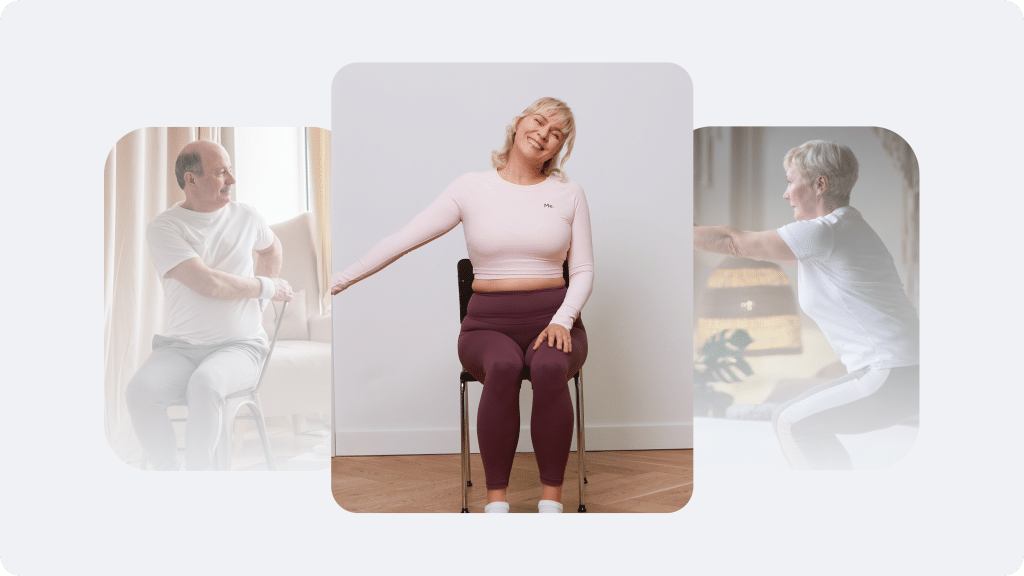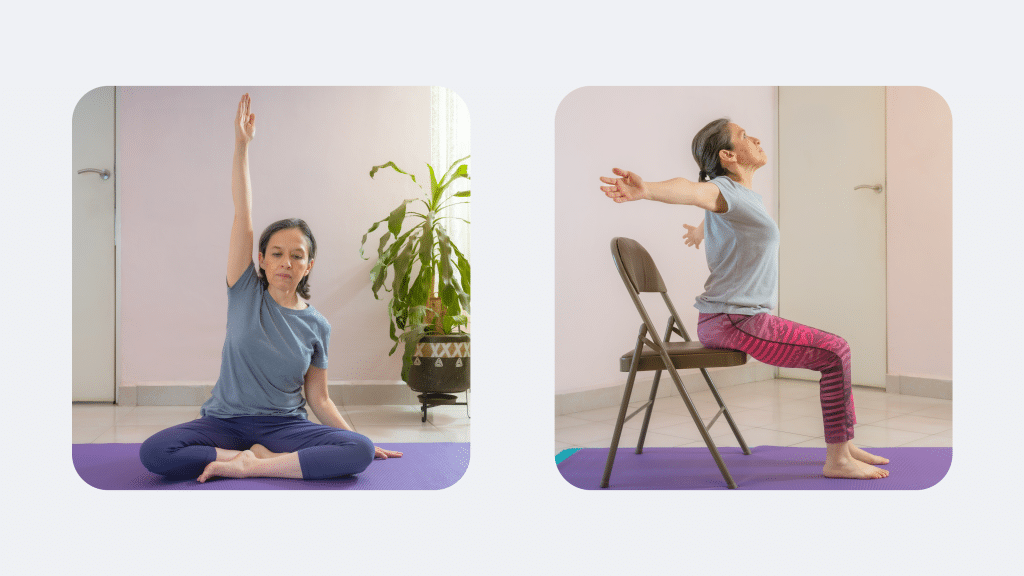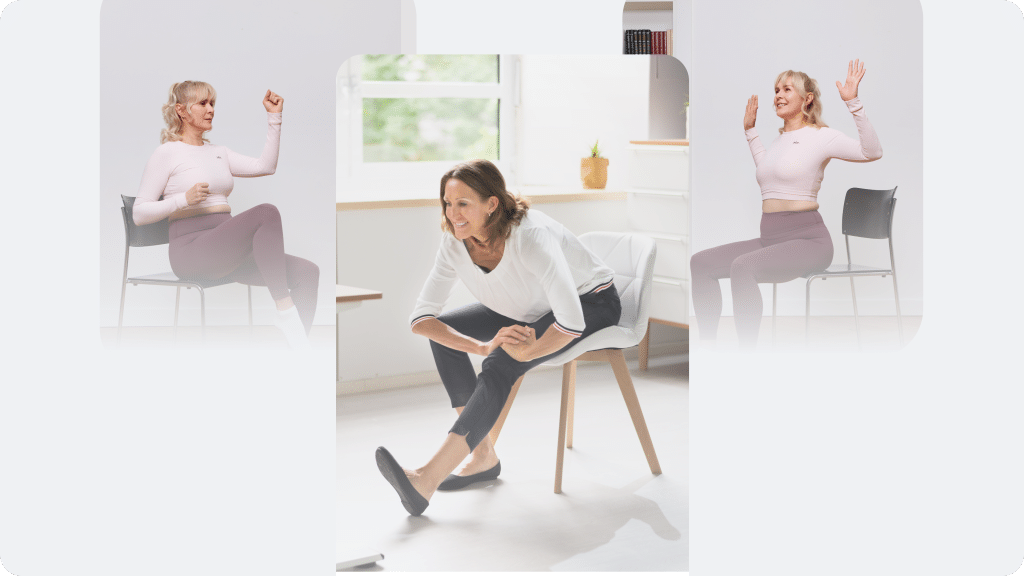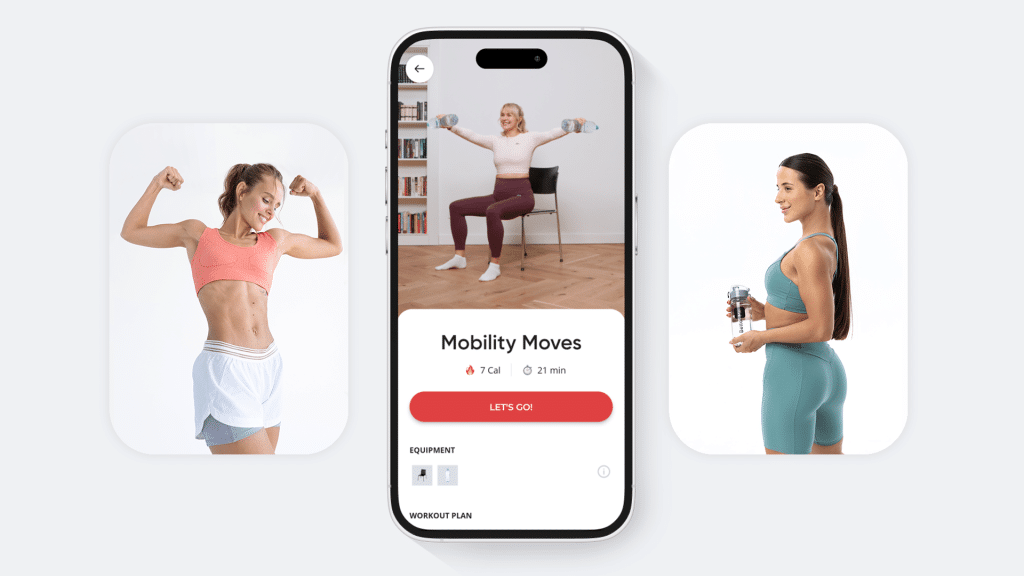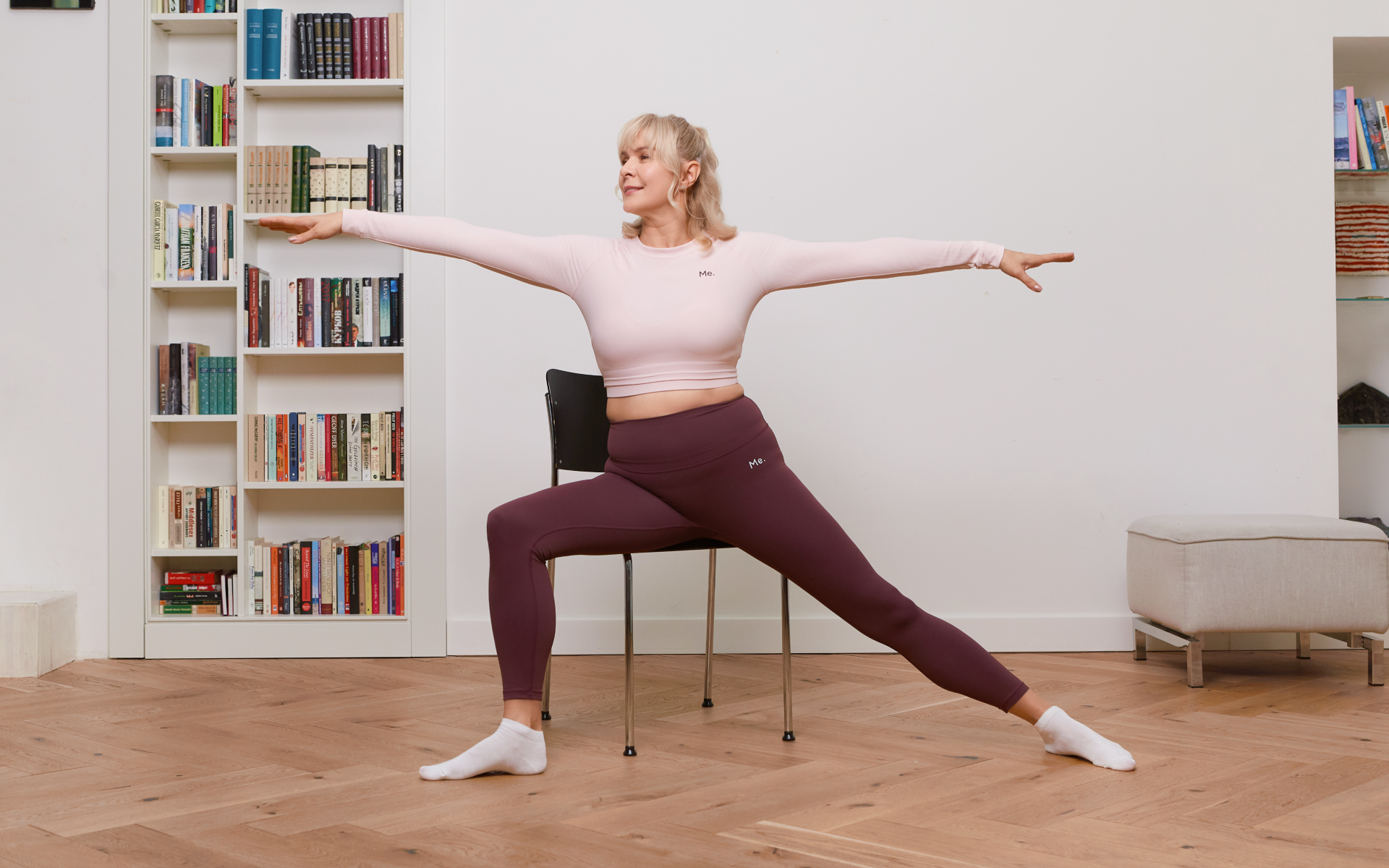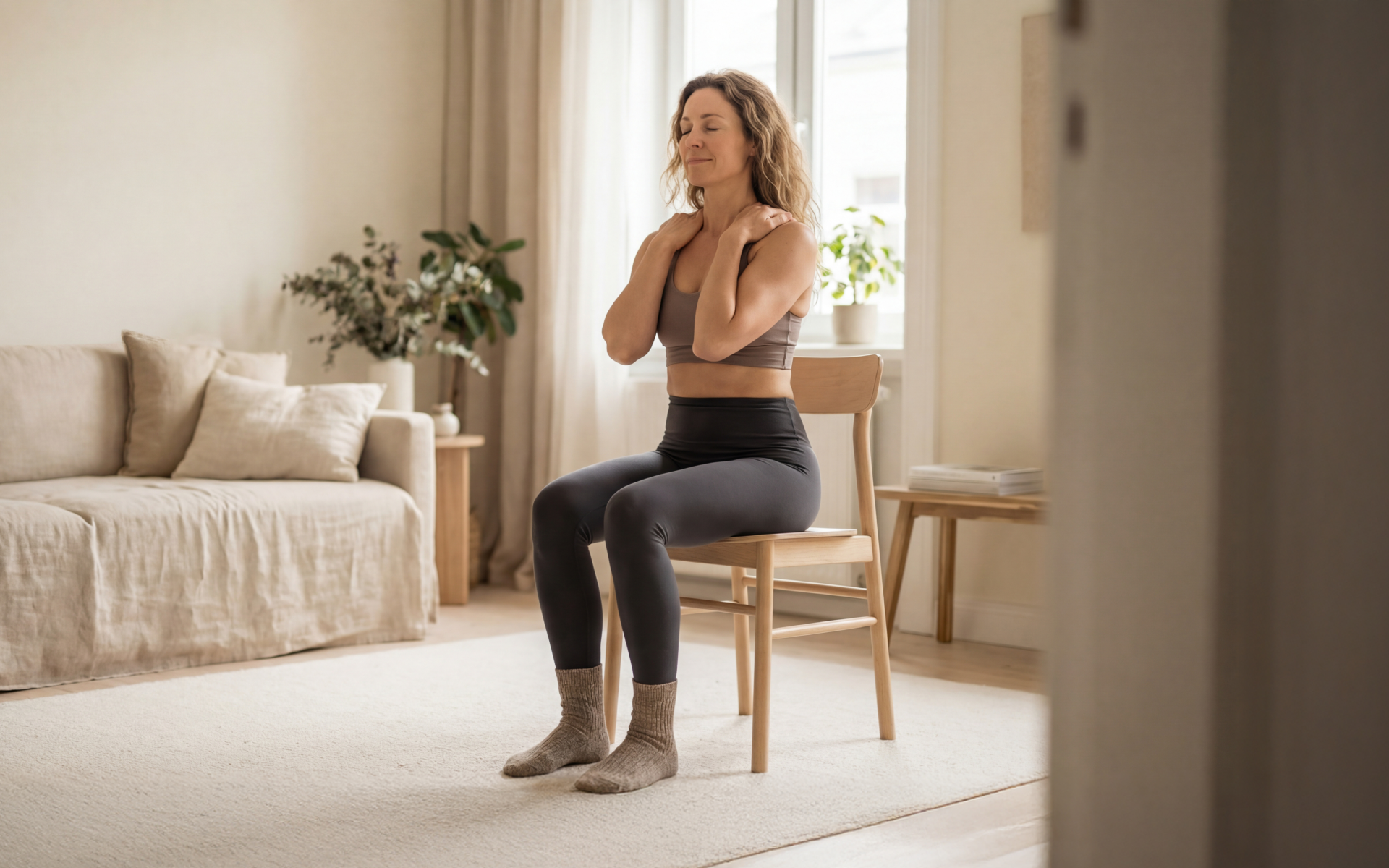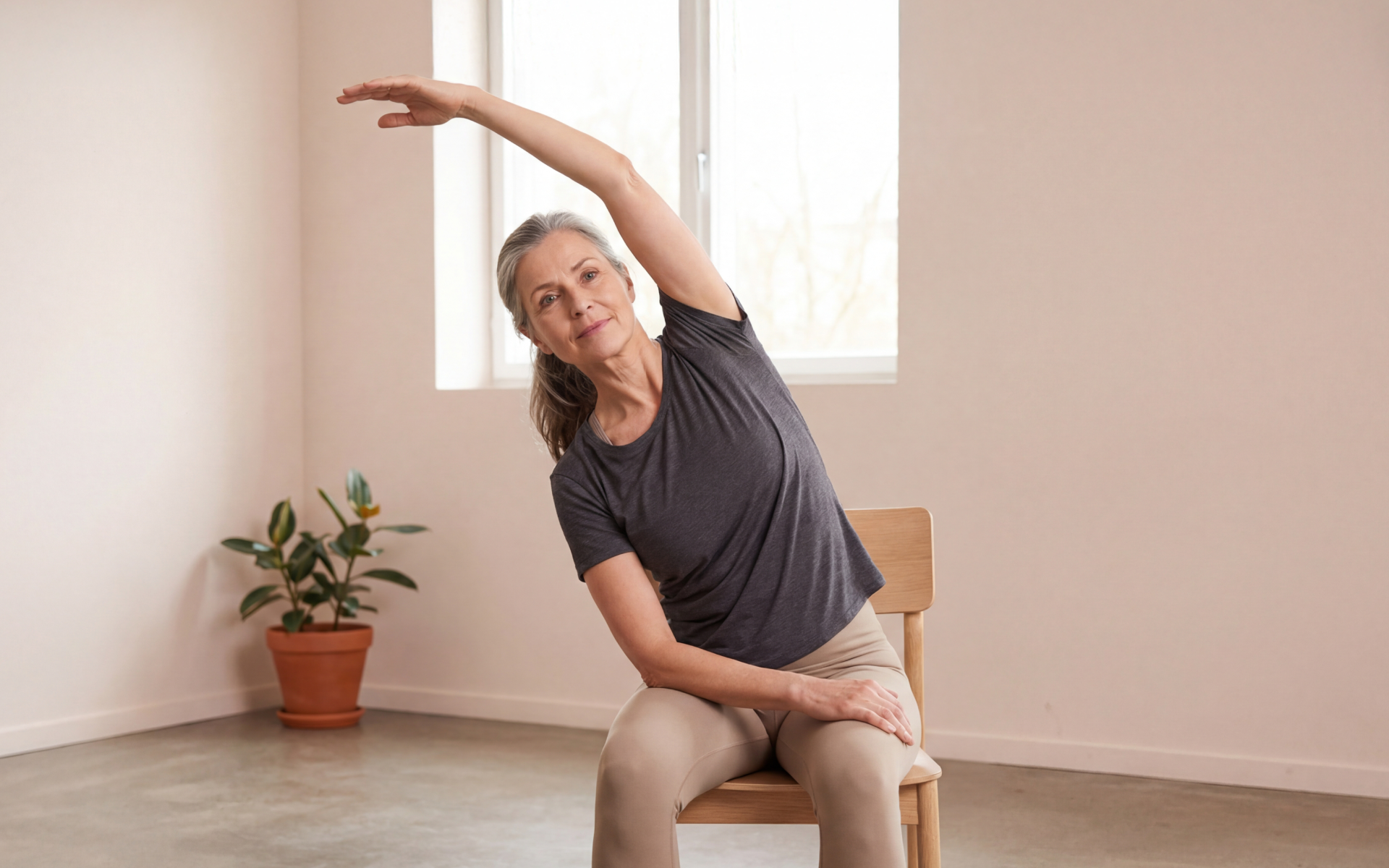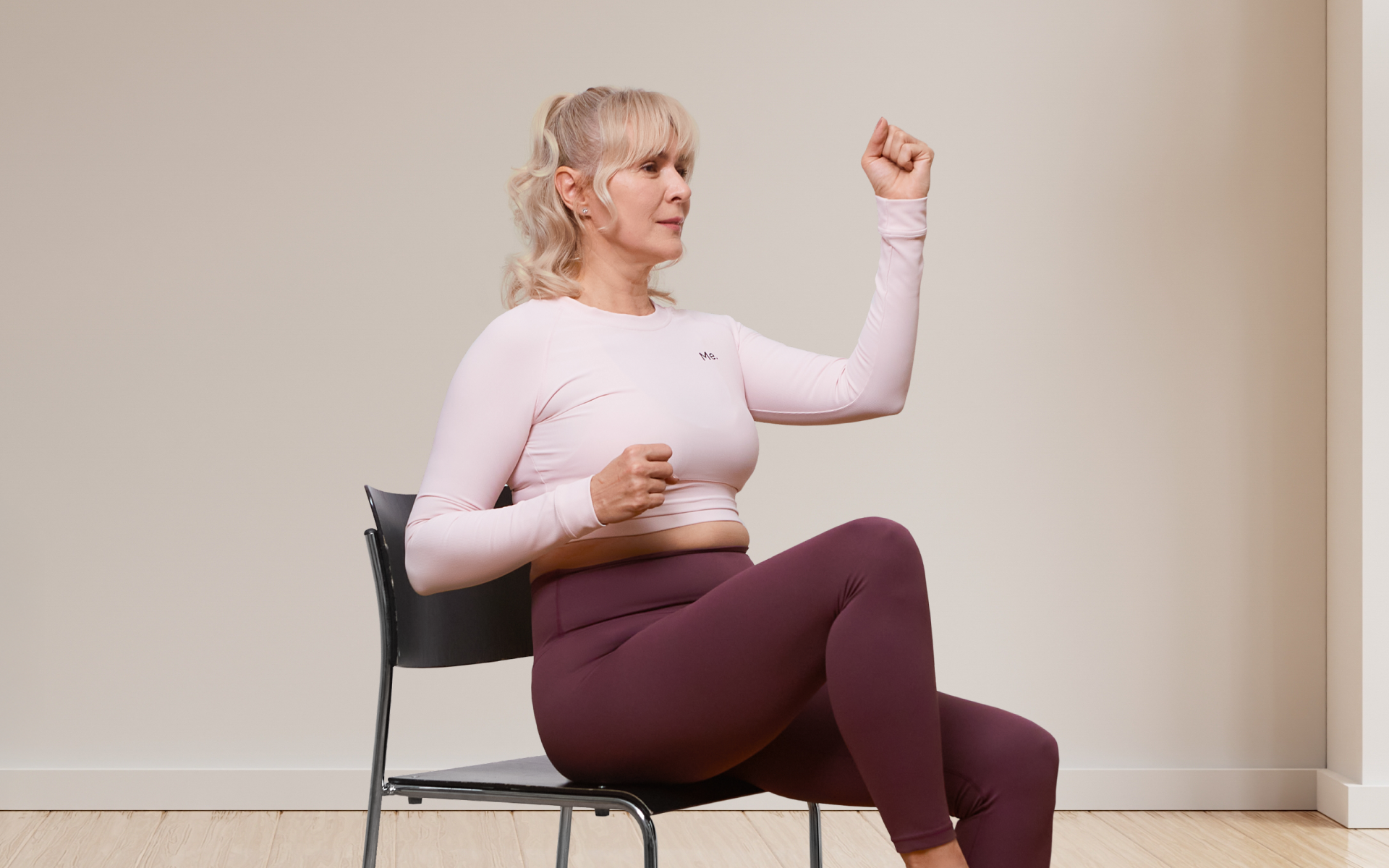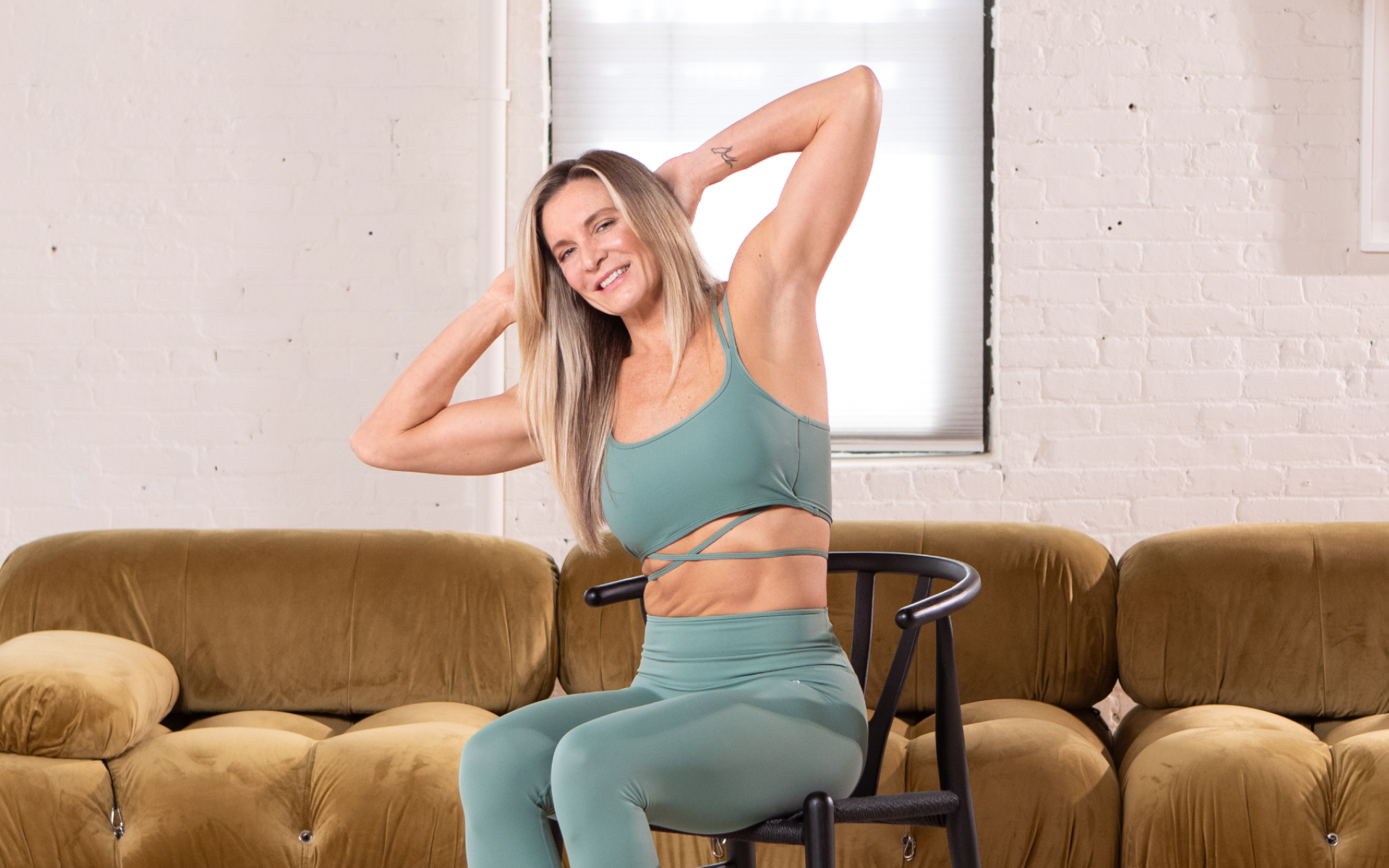Our spine consists of 33 vertebrae stacked on top of each other, with discs acting as shock absorbers between them. These vertebrae allow us to bend, twist, and move in various directions. Around the spine are a complex network of muscles, ligaments, and tendons that support and stabilize it (1).
When we don’t prioritize back mobility, our spine may become stiff and inflexible, leading to muscle imbalances and an increased risk of injury. Poor back mobility can also lead to other issues such as poor posture, decreased range of motion, and chronic pain.
One of the best ways to take care of your spine and the muscles supporting it is through regular exercise. Read on for 7 back mobility exercises that can help you maintain a healthy spine and improve your overall flexibility and strength.
Why Is Lack of Back Mobility Bad?
Back mobility refers to the range of motion and flexibility of the spine and the surrounding muscles. It encompasses the ability to bend, twist, and extend the back, without discomfort or restriction.
Lack of mobility means that the spine is not able to move through its full range of motion, which may lead to stiffness and tightness in the back muscles. This, in turn, can cause imbalances in muscle strength and coordination, leading to poor posture and an increased risk of injury.
In addition, poor back mobility not only affects your ability to exercise properly, it can also affect our daily activities such as sitting, standing, or even walking. When we have limited mobility in our spine, we may compensate by overusing other body parts, which can put strain on them and cause pain.
Read more: Top 10 Balance Exercises for Seniors at Home
It Can Lead to Poor Posture
Poor back mobility often results in an inability to hold an upright posture, leading to slumping or slouching. This misalignment puts additional strain on the neck and shoulders and may cause pain and discomfort over time.
You May Experience Increased Discomfort
Limited flexibility in the back often contributes to muscle tightness. When certain muscles are stiff, they force other muscles and joints to overcompensate during movement, leading to chronic discomfort (2).
It Affects Range of Motion
A lack of mobility restricts the ability to perform daily activities smoothly. Whether turning to look behind you while driving or when bending to pick something up, reduced range of motion makes these tasks more challenging and sometimes painful.
You Risk Injury
Inflexible backs are more prone to injuries, especially during physical activities. When your spine and surrounding muscles cannot move freely, you’re more likely to strain yourself or sprain muscles, ligaments, or tendons (3).
It Impacts Athletic Performance
For athletes, lack of back mobility can hinder performance. Whether you’re a runner needing good spinal alignment or a weightlifter requiring stability, mobility issues can limit your potential and increase the risk of injury during competition.
Looking for a way to break the vicious cycle of weight loss and tone up all the jiggly parts? Watch the extra pounds fly off and your muscles firm up with the BetterMe: Health Coaching app!
You May Develop Muscle Imbalances
Tightness in the back can lead to uneven muscle development. When certain muscles aren’t able to stretch or strengthen properly, others might overwork to compensate. This imbalance will affect your overall movement patterns, leading to further discomfort and potential injuries (4).
It Can Decrease Your Energy Levels
When your back is stiff and lacks mobility, it creates unnecessary tension throughout the body. This tension often translates into fatigue, as other muscles work harder to maintain function. Over time, decreased mobility can sap your energy, making it harder to stay active throughout the day.
You Might Experience Emotional Stress
Physical discomfort from poor back mobility can also take a toll on your mental health. Persistent pain and restricted movement can lead to depression, creating a vicious cycle where emotional stress further impacts physical tension in the body (5).
Maintaining back mobility is crucial not just for physical well-being, but also for emotional balance as well.
How Do I Build Back Mobility?
Building back mobility requires a combination of stretching, strengthening, and proper movement patterns.
Stretching
Stretching helps to increase the range of motion in your back and loosen up any tight muscles (6).
There are two types of stretching: dynamic and static. Dynamic stretches involve moving through a range of motion actively, while static stretches hold the end position for a certain period. Both types of stretching are beneficial and can be incorporated into your daily routine to improve back mobility (7).
Check out our guide – Chair Yoga for Seniors to find out how you can use your own body weight to improve your flexibility and mobility.
Strengthening
Strengthening exercises help build the muscles that support and stabilize the spine, improving overall mobility.
These muscles are often referred to as the “core” muscles, and include the abdominal, back, and hip muscles. Regularly incorporating exercises that target these areas can help improve spinal stability and prevent injury (8).
The posterior chain, which includes the muscles on the back of your body such as the glutes and hamstrings, is also essential for maintaining back mobility. These muscles work together to support proper posture and movement patterns.
Practicing Proper Movement Patterns
Maintain proper movement patterns throughout your day, to avoid putting unnecessary strain on your back. This includes maintaining good posture while sitting and standing, using proper lifting techniques, and avoiding repetitive movements or staying in one position for too long.
Maintaining Good Posture While Standing
To maintain good standing posture while standing (9):
- Even Weight Distribution: Stand with your weight evenly distributed on both feet. Avoid shifting all your weight to one side or the other.
- Feet Shoulder-Width Apart: Keep your feet about shoulder-width apart to provide a stable base of support.
- Engage Your Core: Keep your abdominal muscles slightly engaged to support your lower back.
- Natural Spine Alignment: Your ears, shoulders, and hips should be in a straight line. Avoid leaning forward or backward.
- Use a Footrest: If you have to stand for long periods, rest one foot on a small stool or footrest to reduce lower back pressure.
Maintaining Good Posture While Sitting
When sitting, make sure to (9):
- Align Your Spine: Make sure that your back is straight and your shoulders are relaxed but not slouched. Your buttocks should touch the back of your chair.
- Feet Flat on the Floor: Keep your feet flat on the floor or on a footrest. Avoid crossing your legs as it can distort your spinal alignment.
- Support Your Lower Back: Use a small pillow or a lumbar roll to maintain the natural curve of your lower spine.
- Adjust Your Chair Height: Your knees should be at or slightly below hip level. This helps in reducing strain on your lower back.
- Screen at Eye Level: If you’re working on a computer, the top of the screen should be at or slightly below eye level to avoid neck strain.
Read more: Chair Yoga Positions: Gentle Movements for Strength and Flexibility
Using Proper Lifting Techniques
When lifting objects:
- Plan Your Lift: Before lifting, assess the weight of the object and plan your movements. Make sure the path is clear of obstacles. This is also where that dynamic stretching comes into play. Doing dynamic stretches before a weight lifting session is beneficial for preparing the body to complete lifts and can help to reduce the likelihood of injury.
- Bend Your Knees, Not Your Back: Squat down by bending your knees and hips. Keep your back straight throughout the lift.
- Keep the Object Close: Hold the object as close to your body as possible. This reduces the strain on your back.
- Use Your Legs: Lift by straightening your legs, not your back. Your leg muscles are stronger and more suited to handle the load.
- Avoid Twisting: Do not twist your body while lifting. If you need to turn, pivot your feet instead of twisting your spine.
- Know Your Limits: If the object is too heavy, ask for help or use a mechanical aid.
Avoiding Repetitive Movements
Repetitive movements or prolonged static positions can lead to muscle fatigue and back strain. Here’s how to mitigate these risks:
- Take Regular Breaks: If your work involves repetitive tasks or sitting for long periods, take breaks every 30 minutes to stand up, stretch, and walk around.
- Stretch Regularly: Incorporate stretching exercises into your routine to maintain flexibility and relieve tension. Focus on those muscles that are commonly tight, such as the hamstrings, hip flexors, and lower back.
- Ergonomic Work Environment: Make sure that your work environment is ergonomically designed to reduce repetitive strain. This includes having an adjustable chair, proper desk height, and tools positioned within easy reach.
- Vary Your Tasks: Try to alternate between different tasks to avoid repetitive movements. This can help distribute the workload among different muscle groups.
- Micro-Movements: Even small movements can make a big difference. Shift your weight, change your sitting position, or stand up briefly to keep your muscles active.
What Are Back Mobility Exercises?
In our opinion, the best back mobility exercises are those that strengthen and stretch the key muscles involved in spinal stability. Here are some examples of exercises that can help improve back mobility:
Cat-Cow Stretch
The cat-cow stretch is a gentle exercise that helps to mobilize and loosen up your spine.
- Start on all fours with your hands directly below your shoulders and your knees below your hips.
- Inhale, arching your back and lifting your head towards the ceiling (cat pose).
- Exhale, rounding out your spine and tucking in your chin (cow pose).
- Repeat this movement for 10-15 repetitions, gradually increasing the range of motion.
Bird-Dog
The bird-dog exercise strengthens the core and stabilizes muscles in your back.
- Start on all fours with your hands directly below your shoulders and your knees below your hips.
- Lift one arm and the opposite leg off the ground, keeping them parallel to the floor.
- Hold for a few seconds, then return to the starting position.
- Repeat on the other side for 10-15 repetitions.
Whether you’re looking to simply pep up your fitness routine, jazz up your diet with mouth-watering low-calorie recipes or want to get your act together and significantly drop that number on your scale – BetterMe: Health Coaching app has got you covered! Improve your body and revamp your life!
Glute Bridge
The glute bridge exercise strengthens the glutes and hamstrings, which are essential for maintaining proper posture and movement patterns.
- Lie on your back with your feet flat on the ground, hip-width apart.
- Engage your core and squeeze your glutes as you lift your hips off the ground, creating a straight line from your knees to your shoulders.
- Hold for a few seconds, then lower back down.
- Repeat for 10-15 repetitions.
Child’s Pose
Child’s pose is a relaxing stretch that helps to release tension in the muscles of the back and neck.
- Start on all fours with your hands directly below your shoulders and your knees below your hips.
- Keeping your arms extended, slowly sit back onto your heels while lowering your chest towards the floor.
- Rest your forehead on the ground and hold this position for 30 seconds to one minute.
- Slowly return to the starting position.
Thoracic Spine Rotations
This exercise aims to improve the mobility of your thoracic spine, which is crucial for maintaining upper body flexibility.
- Begin seated cross-legged or on a chair with your feet flat on the floor.
- Place your right hand on your left knee and your left hand behind you on the floor for support.
- Inhale and gently twist your torso to the left, using your hands to deepen the stretch.
- Hold for a few seconds, then exhale as you return to the starting position.
- Repeat on the other side for 5-10 repetitions on each side.
Seated Forward Bend
This stretch targets the lower back and hamstrings, enhancing flexibility and relieving tension.
- Sit on the floor with your legs extended straight in front of you.
- Inhale and reach your arms overhead, lengthening your spine.
- Exhale as you hinge at the hips and reach your hands towards your feet. Keep your back straight.
- Hold the position for 20-30 seconds, feeling the stretch in your lower back and hamstrings before gently returning to seated.
Standing Side Bend
This exercise helps to stretch the lateral muscles of your back and improve overall spine flexibility.
- Stand tall with your feet shoulder-width apart and arms at your sides.
- Inhale and raise your left arm overhead, reaching your hand towards the ceiling.
- Exhale as you bend to the right, keeping your hips facing forward and feeling the stretch along your left side.
- Hold for 15-20 seconds, then return to the starting position and repeat on the other side for 5-10 repetitions.
Our previous guide, Mobility Exercises features more workouts that you can incorporate into your everyday exercise routine.
How Do You Get Your Mobility Back?
The first step toward getting your mobility back is to consult a medical professional to determine the underlying cause of your decreased mobility. They may recommend a combination of physical therapy, medication, and lifestyle changes to help improve your range of motion.
Physical Therapy
Physical therapy is a highly effective treatment for improving mobility. A physical therapist will assess your condition and develop a customized exercise program to target specific areas of weakness or tightness. They may also use manual techniques such as massage, stretching, or joint mobilization to improve flexibility and reduce pain (10).
Medication
In some cases, medication may be prescribed to help manage pain and inflammation associated with decreased mobility.
Never take any medication for back mobility without consulting a doctor first.
Lifestyle Changes
Simple changes in daily habits can have a significant impact on improving mobility. Maintaining a healthy weight can reduce stress on joints, and incorporating more physical activity into your routine can help strengthen muscles and improve flexibility (11). Additionally, practicing good posture and using proper body mechanics when lifting or performing tasks can also protect your back.
How Long Does It Take To Fix Mobility?
It may take from weeks to months to fix mobility issues, depending on the underlying cause and severity of the condition. With consistent treatment and adherence to exercise programs, many people are seeing improvements in their mobility within a few weeks. That said, some conditions take longer to address fully.
It is also essential to maintain good habits and continue with exercises, even after experiencing improvements in mobility to prevent future issues from arising. Regular check-ins with a medical professional can also ensure proper progress is being made and adjustments can be made if necessary.
You unlock lower back mobility by strengthening the muscles and improving flexibility in your lower back, hips, and core. Exercises such as glute bridges, child’s pose, and standing side bends can help improve mobility in this area. Our previous blog – Upper Spine Stretches includes several workouts you can try to help strengthen your upper back muscles. Yes, with proper treatment and consistent effort, it is possible to improve mobility. Similar to building muscle, improving mobility will take time and should be treated in a similar manner to weight lifting. You will want to progressively manipulate your mobility exercises over time to see long term results and prevent yourself from reaching a plateau. Consulting a medical professional and following their recommendations can help you regain lost mobility or prevent further decline in your range of motion. A gentle mobility routine can be done every day, but it is essential to listen to your body and not overdo it. It is also crucial to incorporate rest days and vary exercises to avoid muscle fatigue or strain. Consult a medical professional for personalized recommendations that are based on your specific condition. Mobility and stretching are both crucial for maintaining flexibility and range of motion. While stretching focuses on lengthening muscles, mobility exercises, aim to improve joint movement and muscle coordination. Both should be incorporated into a well-rounded exercise routine for optimal results. Overall, it is essential to find a balance between mobility and stretching that works best for your body and its specific needs. It may take from weeks to months for mobility exercises to show significant improvements. However, consistency and proper form are key factors in seeing results. In terms of duration of daily mobility training, aiming for 5-10 minutes a day should lead to lasting results. Remember, the best workout, whether it be mobility work or a heavy training session, is one that you can do consistently over a long period of time. Additionally, consulting a medical professional and following their recommendations can help ensure safe and effective progress towards better mobility.Frequently Asked Questions
How Do You Unlock Lower Back Mobility?
Can You Actually Improve Mobility?
Should I Do Mobility Everyday?
Is Mobility Better Than Stretching?
How Long Does It Take for Mobility To Work?
Conclusion
Back mobility is crucial for maintaining a healthy spine and reducing the risk of injury. By incorporating exercises that target key muscle groups, seeking professional treatment if needed, and making lifestyle changes, you can improve your back mobility and overall quality of life. Remember to always listen to your body and consult with a medical professional before starting any new exercise program.
DISCLAIMER:
This article is intended for general informational purposes only and does not serve to address individual circumstances. It is not a substitute for professional advice or help and should not be relied on for making any kind of decision-making. Any action taken as a direct or indirect result of the information in this article is entirely at your own risk and is your sole responsibility.
BetterMe, its content staff, and its medical advisors accept no responsibility for inaccuracies, errors, misstatements, inconsistencies, or omissions and specifically disclaim any liability, loss or risk, personal, professional or otherwise, which may be incurred as a consequence, directly or indirectly, of the use and/or application of any content.
You should always seek the advice of your physician or other qualified health provider with any questions you may have regarding a medical condition or your specific situation. Never disregard professional medical advice or delay seeking it because of BetterMe content. If you suspect or think you may have a medical emergency, call your doctor.
SOURCES:
- Anatomy, Back, Vertebral Column (2023, ncbi.nlm.nih.gov)
- Muscle Stiffness: Causes & Treatment (2023, my.clevelandclinic.org)
- Back Strains and Sprains (2018, my.clevelandclinic.org)
- What Are Muscle Imbalances? (2022, webmd.com)
- The Link between Depression and Chronic Pain: Neural Mechanisms in the Brain (2017, ncbi.nlm.nih.gov)
- The importance of stretching (2024, health.harvard.edu)
- Stretching (n.d., physio-pedia.com)
- A Systematic Review of the Effects of Exercise and Physical Activity on Non-Specific Chronic Low Back Pain (2016, ncbi.nlm.nih.gov)
- Guide to Good Posture (2017, medlineplus.gov)
- In brief: Physical therapy (2022, ncbi.nlm.nih.gov)
- Physical activity – it’s important (2023, betterhealth.vic.gov.au)

